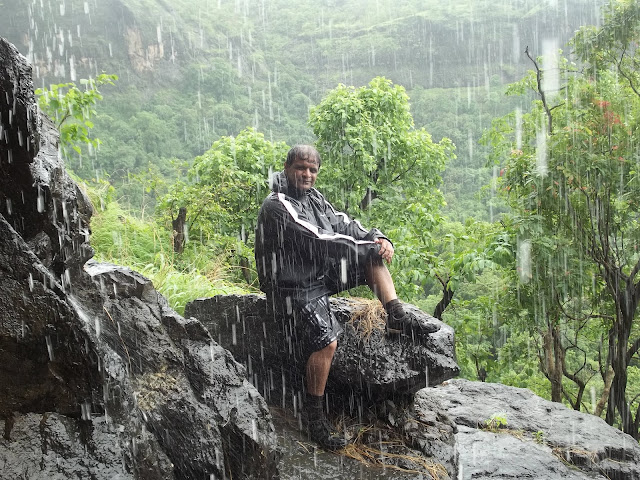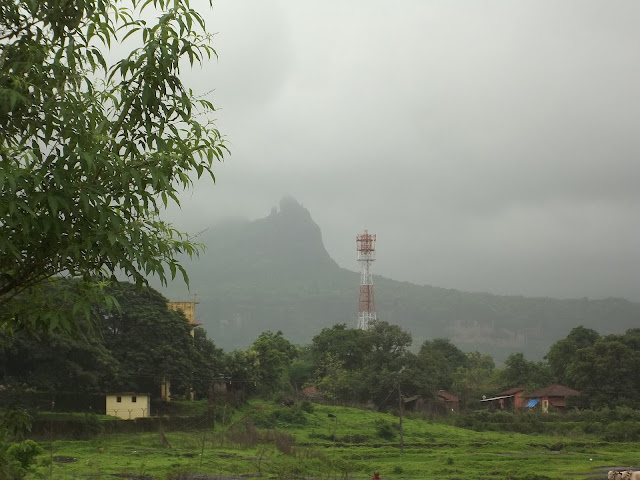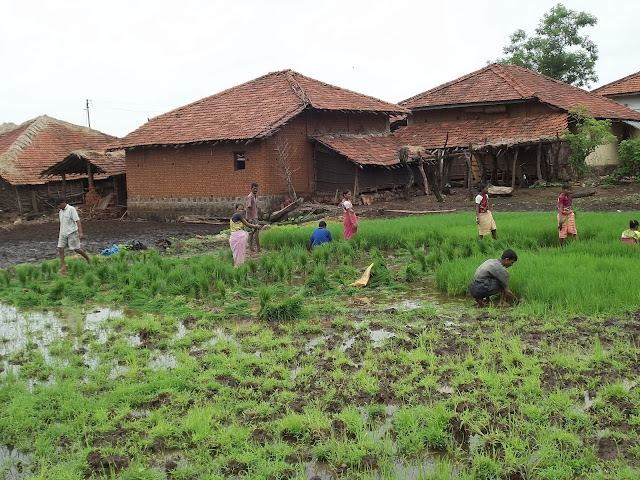We started our trek on the note, "Not another monsoon trek with no rain." This was the hearts cry of all my trek mates. Humidity level shot the roof and tired as we were, we retired for lunch. Tifin boxes and food sharing as usual. Our cry for rain was surely heard. A cool wind blew. The skies were overcast. A huge storm cloud at the hill top suddendly broke down into mist. The lofty hill turned invisible. The great magician was at work. An answered prayer, the miricle before our very eyes. Rain! Rain! Rain!.....with no stop. Waterfall stopover. Rain! Rain!.....with no stop. Waterfall stopover. We had a ball.
Bhimashankar
The beauty of the Western Ghats, the majesty of Sahayadri mountains, and the blessings of lord “Shiva” make this place a real treat for the nature lovers. The Bhimashankar Wildlife Sanctuary is one of the most beautiful wildlife sanctuaries in India rich in birds and insects, butterflies and wildflowers, reptiles and medicinal plants.
Bhimashankar Sanctuary has always been my favorite forest and on more than 6 occasions that I visited this place, I always had magnificent experiences of nature’s wonders. The tranquility that this place offers, far from the maddening human world, is something that will make you visit this place again and again and again……such is the magic of Bhimashankar – the Sacred Forest.
This forest was declared by the govt. of Maharashtra on 10th Oct 1985 as a reserve forest for the Malabar Giant Squirrel also called as “Shekru” in Marathi, the state animal of Maharashtra and a huge number of other animals and birds. It covers a forest area of 130.78 sq. km.
The Sanctuary is positioned at an altitude of 2,100 feet to 3,800 feet. It is located in the Ambegaon taluka of Pune district, Maharashtra, in fact it spreads over Pune, Raigad and Thane districts of the north-western part of Maharashtra. The Bhimashankar temple situated here is one of the 12 Jyotirlinga temples of Lord Shiva and is visited by hundreds of devotees. However, due to the long distance and poor facilities, this is also one of the less visited “Jyotirlingas” ……. which is good for the forest :-)
The valley found beyond this temple is a wonderful combination of shrubs, medicinal herbs and plant life and serves as the catchment area for the Bhima, Ghod and Arala rivers, which empty into the Krishna. It receives heavy monsoon rainfall of approx. 6000 mm annually.
This is one of the best habitats in the Western Ghats for the Malabar giant squirrel and there are confirmed sightings of tigers too. However, tourism projects which seek to build in the heart of the forest threaten the arboreal ecology of these creatures. Proposed roads also threaten the forest, as do development projects designed to cater to the needs of pilgrims who visit the nearby temple complex.
Flora: It contains relic forest with a high diversity of endangered evergreen tree species many of which are endemic to the Western Ghats. The main forest type of this sanctuary is the southern tropical semi evergreen forest. A wide range of plant life, medicinal herbs, and shrubs can be found here. The major flora found in Bhimashankar wildlife sanctuary includes Bamboo, Palash, Babul, Bija, Salaia, Tendu, Dhawda, Zizyphus Helicteris, Khair, Sal, Terminenalia sps, Casia auriculata, Bel, Hiwar, Teak, Hirda, Behada, Jamun, Fig, Anjan etc. The commonly found shrubs include varieties of Ixora, Vitex Nigundo, Lantana etc. and many species of herbs, climbers, grass and ferns.
In the monsoon season, one can spot bioluminous fungi growing on some trees. The fungus gives out a faint glow that makes the tree trunks shimmer gently in the darkness of the night.
Fauna: The area is rich in fauna since there are various forest types found in the sanctuary. The wild life found here includes Malabar Giant Squirrel (of the ssp. Ratufa indica elphinstonii), Leopards, Barking Deer, Sambar, Wild Boar, Langur, Hares, Pangolin, Civet cats, and occasionally Hyena. More than 150 species of birds are found in Bhimashankar WLS and the surrounding areas. Among the birds that one encounters here include White-Bellied Blue flycatcher, Puff-throated babbler, Malabar Grey Hornbill, Brown cheeked Fulvetta, Malabar Whistling Thrush, Nilgiri Wood Pigeon, Black Bulbul, Indian Black Bird, Black Eagle, Bonelli’s eagle, Yellow-browed Bulbul, Emerald Doves, Oriental turtle dove, Grey Jungle Fowl and many, many more. One might get to see the great butterfly and moth brigade including several species. The Insect life is tremendous here and the reptiles are in plenty.
Bhimashankar Temple
Bhimashankar Temple is in the village of Shiradhon 50 km northwest of Khed, near Pune, in India. It is located 127 km from Shivaji Nagar (Pune) in the Ghat region of the Sahyadri hills. Bhimashankar is also the source of the river Bhima, which flows southeast and merges with the Krishna river near Raichur. The other Jyotirlinga shrines in Maharashtra are Trimbakeshwara near Nashik and Grishneshwar near Ellora around Aurangabad.
Jyotirlinga
As per Shiv Mahapuran, once Brahma (the Hindu God of creation) and Vishnu (the Hindu God of saving) had an argument in terms of supremacy of creation. To test them, Shiva pierced the three worlds as a huge endless pillar of light, the jyotirlinga. Vishnu and Brahma split their ways to downwards and upwards respectively to find the end of the light in either directions. Brahma lied that he found out the end, while Vishnu conceded his defeat. Shiva appeared as a second pillar of light and cursed Brahma that he would have no place in ceremonies while Vishnu would be worshipped till the end of eternity. The jyotirlinga is the supreme partless reality, out of which Shiva partly appears. The jyothirlinga shrines, thus are places where Shiva appeared as a fiery column of light. Originally there were believed to be 64 jyothirlingas while 12 of them are considered to be very auspicious and holy. Each of the twelve jyothirlinga sites take the name of the presiding deity - each considered different manifestation of Shiva. At all these sites, the primary image is lingam representing the beginningless and endless Stambha pillar, symbolizing the infinite nature of Shiva. The twelve jyothirlinga are Somnath in Gujarat, Mallikarjuna at Srisailam in Andra Pradesh, Mahakaleswar at Ujjain in Madhya Pradesh, Omkareshwar in Madhya Pradesh, Kedarnath in Himalayas, Bhimashankar in Maharastra, Viswanath at Varanasi in Uttar Pradesh, Triambakeshwar in Maharastra, Vaidyanath at Deogarh in Jharkand, Nageswar at Dwarka in Gujarat, Rameshwar at Rameswaram in Tamil Nadu and Grishneshwar at Aurangabad in Maharastra.
Bhimashankar
The beauty of the Western Ghats, the majesty of Sahayadri mountains, and the blessings of lord “Shiva” make this place a real treat for the nature lovers. The Bhimashankar Wildlife Sanctuary is one of the most beautiful wildlife sanctuaries in India rich in birds and insects, butterflies and wildflowers, reptiles and medicinal plants.
Bhimashankar Sanctuary has always been my favorite forest and on more than 6 occasions that I visited this place, I always had magnificent experiences of nature’s wonders. The tranquility that this place offers, far from the maddening human world, is something that will make you visit this place again and again and again……such is the magic of Bhimashankar – the Sacred Forest.
This forest was declared by the govt. of Maharashtra on 10th Oct 1985 as a reserve forest for the Malabar Giant Squirrel also called as “Shekru” in Marathi, the state animal of Maharashtra and a huge number of other animals and birds. It covers a forest area of 130.78 sq. km.
The Sanctuary is positioned at an altitude of 2,100 feet to 3,800 feet. It is located in the Ambegaon taluka of Pune district, Maharashtra, in fact it spreads over Pune, Raigad and Thane districts of the north-western part of Maharashtra. The Bhimashankar temple situated here is one of the 12 Jyotirlinga temples of Lord Shiva and is visited by hundreds of devotees. However, due to the long distance and poor facilities, this is also one of the less visited “Jyotirlingas” ……. which is good for the forest :-)
The valley found beyond this temple is a wonderful combination of shrubs, medicinal herbs and plant life and serves as the catchment area for the Bhima, Ghod and Arala rivers, which empty into the Krishna. It receives heavy monsoon rainfall of approx. 6000 mm annually.
This is one of the best habitats in the Western Ghats for the Malabar giant squirrel and there are confirmed sightings of tigers too. However, tourism projects which seek to build in the heart of the forest threaten the arboreal ecology of these creatures. Proposed roads also threaten the forest, as do development projects designed to cater to the needs of pilgrims who visit the nearby temple complex.
Flora: It contains relic forest with a high diversity of endangered evergreen tree species many of which are endemic to the Western Ghats. The main forest type of this sanctuary is the southern tropical semi evergreen forest. A wide range of plant life, medicinal herbs, and shrubs can be found here. The major flora found in Bhimashankar wildlife sanctuary includes Bamboo, Palash, Babul, Bija, Salaia, Tendu, Dhawda, Zizyphus Helicteris, Khair, Sal, Terminenalia sps, Casia auriculata, Bel, Hiwar, Teak, Hirda, Behada, Jamun, Fig, Anjan etc. The commonly found shrubs include varieties of Ixora, Vitex Nigundo, Lantana etc. and many species of herbs, climbers, grass and ferns.
In the monsoon season, one can spot bioluminous fungi growing on some trees. The fungus gives out a faint glow that makes the tree trunks shimmer gently in the darkness of the night.
Fauna: The area is rich in fauna since there are various forest types found in the sanctuary. The wild life found here includes Malabar Giant Squirrel (of the ssp. Ratufa indica elphinstonii), Leopards, Barking Deer, Sambar, Wild Boar, Langur, Hares, Pangolin, Civet cats, and occasionally Hyena. More than 150 species of birds are found in Bhimashankar WLS and the surrounding areas. Among the birds that one encounters here include White-Bellied Blue flycatcher, Puff-throated babbler, Malabar Grey Hornbill, Brown cheeked Fulvetta, Malabar Whistling Thrush, Nilgiri Wood Pigeon, Black Bulbul, Indian Black Bird, Black Eagle, Bonelli’s eagle, Yellow-browed Bulbul, Emerald Doves, Oriental turtle dove, Grey Jungle Fowl and many, many more. One might get to see the great butterfly and moth brigade including several species. The Insect life is tremendous here and the reptiles are in plenty.
Bhimashankar Temple
Bhimashankar Temple is in the village of Shiradhon 50 km northwest of Khed, near Pune, in India. It is located 127 km from Shivaji Nagar (Pune) in the Ghat region of the Sahyadri hills. Bhimashankar is also the source of the river Bhima, which flows southeast and merges with the Krishna river near Raichur. The other Jyotirlinga shrines in Maharashtra are Trimbakeshwara near Nashik and Grishneshwar near Ellora around Aurangabad.
Jyotirlinga
As per Shiv Mahapuran, once Brahma (the Hindu God of creation) and Vishnu (the Hindu God of saving) had an argument in terms of supremacy of creation. To test them, Shiva pierced the three worlds as a huge endless pillar of light, the jyotirlinga. Vishnu and Brahma split their ways to downwards and upwards respectively to find the end of the light in either directions. Brahma lied that he found out the end, while Vishnu conceded his defeat. Shiva appeared as a second pillar of light and cursed Brahma that he would have no place in ceremonies while Vishnu would be worshipped till the end of eternity. The jyotirlinga is the supreme partless reality, out of which Shiva partly appears. The jyothirlinga shrines, thus are places where Shiva appeared as a fiery column of light. Originally there were believed to be 64 jyothirlingas while 12 of them are considered to be very auspicious and holy. Each of the twelve jyothirlinga sites take the name of the presiding deity - each considered different manifestation of Shiva. At all these sites, the primary image is lingam representing the beginningless and endless Stambha pillar, symbolizing the infinite nature of Shiva. The twelve jyothirlinga are Somnath in Gujarat, Mallikarjuna at Srisailam in Andra Pradesh, Mahakaleswar at Ujjain in Madhya Pradesh, Omkareshwar in Madhya Pradesh, Kedarnath in Himalayas, Bhimashankar in Maharastra, Viswanath at Varanasi in Uttar Pradesh, Triambakeshwar in Maharastra, Vaidyanath at Deogarh in Jharkand, Nageswar at Dwarka in Gujarat, Rameshwar at Rameswaram in Tamil Nadu and Grishneshwar at Aurangabad in Maharastra.



































































































No comments:
Post a Comment